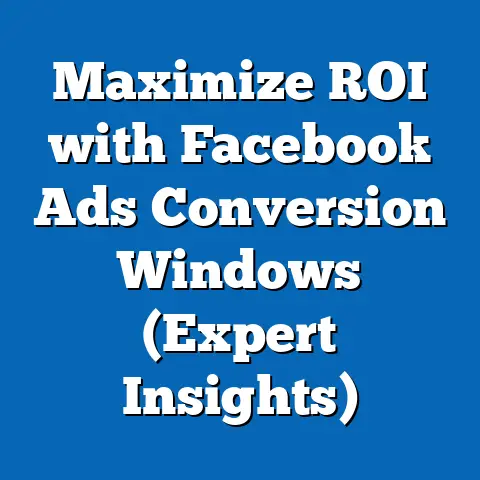Revolutionize Facebook Ads Payments (Expert Insights)
What if the way we pay for digital advertising could fundamentally transform the accessibility, efficiency, and equity of online marketing? As businesses and marketers increasingly rely on platforms like Facebook (now Meta) to reach vast audiences, the mechanisms behind ad payments have become a critical yet often overlooked component of the digital economy. This article delves into the evolving landscape of Facebook Ads payments, exploring how innovations in payment systems are redefining the advertising ecosystem, their historical context, key defining characteristics, and the broader societal implications of these shifts.
The digital advertising industry, valued at over $700 billion globally in 2023 (according to Statista), hinges on seamless and scalable payment systems to fuel campaigns that drive commerce and communication. Facebook Ads, as one of the dominant players in this space, processes billions of dollars in transactions annually, catering to everyone from small businesses to multinational corporations. Revolutionizing how these payments are made—through emerging technologies, alternative currencies, and streamlined processes—has the potential to reshape who can advertise, how much they pay, and how effectively they reach their target audiences.
Defining Characteristics of Facebook Ads Payment Innovations
At the core of the revolution in Facebook Ads payments are several defining characteristics that distinguish these innovations from traditional payment systems. First, there is a push toward greater accessibility through diverse payment methods, including digital wallets, cryptocurrencies, and localized payment options tailored to different regions. This shift aims to reduce barriers for small businesses and entrepreneurs in emerging markets, where access to traditional banking systems may be limited.
Second, automation and AI-driven optimization are becoming integral to payment processes. Tools that automatically adjust budgets based on campaign performance or predict optimal payment schedules are minimizing manual intervention and reducing costs for advertisers. Additionally, transparency in pricing and billing, driven by blockchain-inspired technologies, is addressing long-standing concerns about hidden fees and discrepancies in ad spend reporting.
Finally, security and fraud prevention are paramount in this evolving landscape. With cyber threats on the rise, Meta has invested heavily in encryption and fraud detection mechanisms to protect advertisers’ financial data. These characteristics collectively signal a move toward a more inclusive, efficient, and trustworthy payment ecosystem for digital advertising.
Historical Context: The Evolution of Digital Ad Payments
To understand the current wave of innovation in Facebook Ads payments, it’s essential to trace the historical trajectory of digital advertising and payment systems. When online advertising emerged in the late 1990s with platforms like Yahoo! and early Google AdWords, payments were rudimentary, often requiring manual bank transfers or credit card transactions with limited scalability. These early systems were prone to inefficiencies, delays, and high transaction fees, particularly for international advertisers.
Facebook entered the advertising scene in 2007 with the launch of its ad platform, initially targeting college students before expanding globally. At the time, payment methods were largely restricted to credit cards and PayPal, reflecting the dominant financial infrastructure of the era. However, as the platform grew to over 2.9 billion monthly active users by 2023, the need for a more robust and inclusive payment system became evident, especially to accommodate diverse global markets.
The 2010s marked a turning point with the rise of mobile payments and digital wallets like Apple Pay and Google Pay, which Meta began integrating into its payment options. Additionally, the emergence of cryptocurrencies and blockchain technology introduced new possibilities for decentralized and transparent transactions. Historical events like the 2018 Cambridge Analytica scandal also heightened scrutiny over data privacy and financial transactions on the platform, pushing Meta to prioritize secure payment innovations.
Technological Drivers of Payment Revolution in Facebook Ads
Technology is the backbone of the ongoing transformation in Facebook Ads payments. One of the most significant advancements is the integration of artificial intelligence (AI) and machine learning (ML) into payment and budgeting systems. AI algorithms can now analyze real-time campaign data to recommend optimal payment allocations, ensuring advertisers maximize their return on investment (ROI) without overspending.
Blockchain technology is another game-changer, offering a decentralized ledger system that enhances transparency in ad spend. For instance, blockchain can track every transaction associated with an ad campaign, ensuring that advertisers are billed accurately for impressions and clicks. This addresses a long-standing issue in digital advertising: the lack of verifiable data on ad performance and associated costs.
Moreover, the rise of cryptocurrencies and stablecoins presents an alternative to traditional fiat currencies for ad payments. While Meta’s own cryptocurrency project, Diem (formerly Libra), was discontinued in 2022 due to regulatory challenges, the company continues to explore crypto-based payment options. Such innovations could reduce transaction fees and enable faster cross-border payments, particularly benefiting advertisers in regions with volatile local currencies.
Economic Implications: Democratizing Access to Advertising
Economically, revolutionizing Facebook Ads payments has the potential to democratize access to digital advertising. Traditional payment systems often exclude small businesses and individuals in developing economies due to high transaction fees, currency conversion costs, and lack of access to credit cards. By integrating localized payment methods—such as mobile money platforms like M-Pesa in Africa—or accepting cryptocurrencies, Meta can lower the entry barrier for these advertisers.
This inclusivity aligns with broader economic trends toward financial digitization. According to a 2022 report by the World Bank, over 1.4 billion people remain unbanked, yet many have access to mobile phones and digital payment systems. Enabling these populations to participate in digital advertising could unlock new markets for Meta while fostering economic growth in underserved regions.
However, there are challenges to consider. The volatility of cryptocurrencies, for instance, poses risks for advertisers who may see their ad budgets fluctuate with market conditions. Additionally, the cost of implementing cutting-edge payment technologies could initially burden smaller advertisers if Meta passes on those expenses through higher ad rates.
Social and Cultural Impacts: Shaping Digital Engagement
The social and cultural implications of revolutionized Facebook Ads payments are profound, as they influence who can participate in the digital public square. Advertising on platforms like Facebook is not just about selling products; it’s about shaping narratives, influencing public opinion, and building communities. By making ad payments more accessible, Meta can empower marginalized voices—such as small advocacy groups or local cultural organizations—to reach wider audiences.
On the flip side, this democratization also raises concerns about misinformation and the potential for bad actors to exploit low-cost advertising. The 2016 U.S. presidential election highlighted how affordable ad campaigns on Facebook could be weaponized to spread divisive content. As payment systems become more inclusive, Meta must balance accessibility with robust content moderation and fraud prevention to prevent abuse.
Culturally, the shift toward digital payments reflects a broader societal move away from cash-based economies. In regions where digital literacy is still developing, this could exacerbate inequalities if individuals and businesses lack the skills or infrastructure to adopt new payment methods. Addressing this digital divide will be critical to ensuring that payment innovations do not inadvertently exclude vulnerable populations.
Comparative Analysis: Traditional vs. Innovative Payment Systems
Comparing traditional payment systems for Facebook Ads with emerging innovations reveals stark differences in accessibility, efficiency, and security. Traditional methods, primarily credit cards and bank transfers, are widely accepted but often come with high fees, especially for international transactions. They also exclude unbanked populations and require manual input for budgeting and billing, which can be time-consuming for advertisers managing large campaigns.
In contrast, innovative systems like digital wallets, AI-driven budgeting tools, and blockchain-based transparency offer greater efficiency and inclusivity. Digital wallets reduce transaction costs and processing times, while AI tools automate budget allocation to optimize ad spend. Blockchain ensures that advertisers can trust the accuracy of billing data, addressing a pain point in traditional systems where discrepancies often go unresolved.
However, these innovations are not without drawbacks. The learning curve associated with new technologies may deter less tech-savvy advertisers, and the regulatory uncertainty surrounding cryptocurrencies could limit their adoption. A balanced approach that integrates the reliability of traditional systems with the benefits of innovation may be the most effective path forward.
Workplace and Industry Implications: Adapting to Change
The revolution in Facebook Ads payments has significant implications for the marketing and advertising industries. For marketing professionals, the adoption of AI and automated payment tools can streamline workflows, allowing them to focus on creative strategy rather than financial logistics. However, it also demands new skills, such as understanding blockchain or navigating cryptocurrency transactions, which may require upskilling or reskilling.
For businesses, particularly small and medium-sized enterprises (SMEs), accessible payment systems can level the playing field, enabling them to compete with larger corporations for ad space. A 2021 survey by Hootsuite found that 58% of SMEs struggle with digital advertising costs due to payment barriers. Innovations that reduce these barriers could spur greater competition and innovation in the marketplace.
At the industry level, Meta’s push for payment innovation could set a precedent for other digital platforms like Google Ads or TikTok Ads to follow suit. This could lead to a broader industry shift toward more transparent, efficient, and inclusive payment ecosystems, ultimately benefiting advertisers and consumers alike. However, it also raises questions about data privacy and the ethical use of financial data in advertising, which regulators will need to address.
Expert Insights: Voices from the Field
To gain a deeper understanding of this revolution, we turn to expert perspectives from the digital advertising and fintech sectors. Dr. Emily Carter, a digital marketing professor at Stanford University, emphasizes the transformative potential of AI in payment systems. “AI-driven budgeting tools are not just about saving time; they’re about precision. Advertisers can now allocate funds in real-time based on performance data, which was unimaginable a decade ago,” she notes.
On the topic of blockchain, fintech consultant Rajesh Kapoor highlights its role in building trust. “Advertisers have long been frustrated by opaque billing practices in digital ads. Blockchain can provide an immutable record of every transaction, ensuring accountability at every step,” Kapoor explains. However, he cautions that widespread adoption will depend on regulatory clarity and user education.
Meanwhile, Maria Gonzalez, a small business owner who advertises on Facebook, offers a practical perspective. “As someone based in Latin America, payment options like mobile money have been a game-changer. I no longer worry about currency conversion fees eating into my ad budget,” she says. Her experience underscores the real-world impact of payment inclusivity on everyday advertisers.
Nuances and Diversity in Payment Adoption
While the potential of revolutionized Facebook Ads payments is immense, it’s critical to acknowledge the nuances and diversity in adoption across regions, industries, and demographics. In developed economies like the U.S. and Europe, advertisers may readily embrace AI tools and digital wallets due to high digital literacy and infrastructure. However, in regions with limited internet access or financial inclusion, such as parts of Sub-Saharan Africa, the transition may be slower and require targeted support.
Industry-specific differences also play a role. E-commerce businesses, for instance, may prioritize payment systems that integrate seamlessly with their sales platforms, while non-profits may value low-cost options above all else. Additionally, generational differences among advertisers—such as tech-savvy Gen Z entrepreneurs versus older business owners—can influence the pace of adoption and preference for certain payment methods.
These variations highlight the importance of a flexible, multi-pronged approach to payment innovation. Meta must tailor its solutions to diverse needs while investing in education and infrastructure to bridge gaps in access and understanding.
Societal Implications: Opportunities and Challenges
The broader societal implications of revolutionizing Facebook Ads payments are multifaceted. On one hand, greater accessibility to advertising can empower underrepresented groups to amplify their voices, fostering a more inclusive digital economy. This aligns with global development goals, such as the United Nations’ Sustainable Development Goal 10, which focuses on reducing inequalities.
On the other hand, challenges such as digital exclusion, misinformation risks, and data privacy concerns loom large. If payment innovations disproportionately benefit tech-savvy or wealthier advertisers, they could widen existing inequalities rather than narrow them. Additionally, the integration of financial data with advertising platforms raises ethical questions about how this information is used and protected.
Governments and regulators will play a crucial role in shaping the trajectory of these innovations. Policies that promote financial inclusion, protect consumer data, and mitigate fraud will be essential to ensuring that the benefits of payment revolutions are widely shared. Without such oversight, there is a risk that these advancements could prioritize corporate profits over societal good.
Forward-Looking Insights: The Future of Facebook Ads Payments
Looking ahead, the future of Facebook Ads payments is both promising and uncertain. Emerging technologies like decentralized finance (DeFi) and central bank digital currencies (CBDCs) could further disrupt traditional payment models, offering new ways to fund ad campaigns with minimal intermediaries. Meta’s continued experimentation with these technologies suggests that the company is positioning itself at the forefront of this transformation.
However, several unknowns remain. Regulatory hurdles, particularly around cryptocurrencies and data privacy, could slow the pace of innovation or limit its scope. Consumer trust will also be a critical factor—if advertisers perceive new payment systems as insecure or overly complex, adoption rates may stagnate.
Despite these uncertainties, one thing is clear: the revolution in Facebook Ads payments is part of a larger shift toward a more connected, digital-first economy. As Meta and other platforms refine their payment ecosystems, the ripple effects will be felt across industries, cultures, and societies. The challenge will be to harness these innovations in a way that maximizes inclusivity, transparency, and trust while minimizing risks and disparities.
Conclusion
The revolution in Facebook Ads payments represents a pivotal moment in the evolution of digital advertising. By embracing technologies like AI, blockchain, and alternative currencies, Meta is paving the way for a more accessible, efficient, and secure payment ecosystem that could redefine who participates in online marketing and how they do so. Yet, as this analysis has shown, the path forward is fraught with challenges, from digital exclusion to regulatory uncertainty.
Historically, payment systems have shaped the accessibility of commerce and communication, and today’s innovations are no exception. The societal implications—ranging from economic empowerment to cultural inclusion—underscore the stakes of getting this revolution right. As we move into an increasingly digital future, stakeholders across industries must collaborate to ensure that these advancements serve as a force for equity and progress, rather than division and disparity.
In the end, the question remains: Will the revolution in Facebook Ads payments truly democratize digital advertising, or will it introduce new barriers and complexities? Only time, coupled with thoughtful policy and innovation, will provide the answer.






